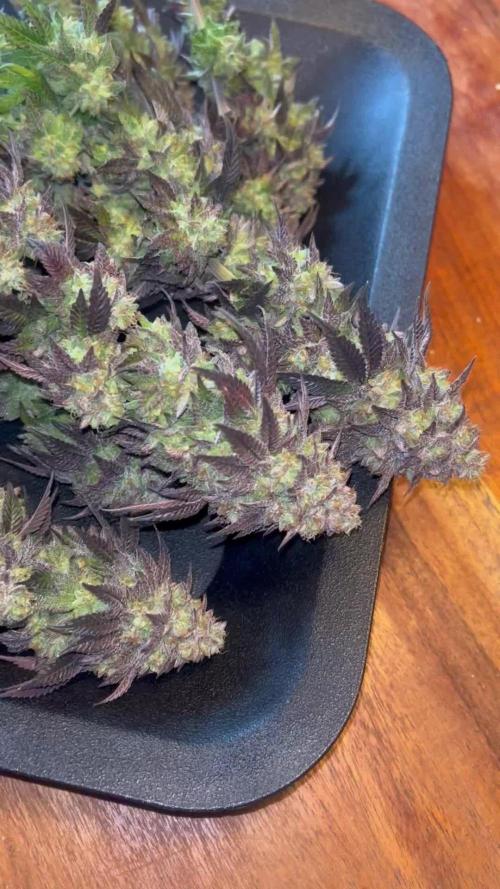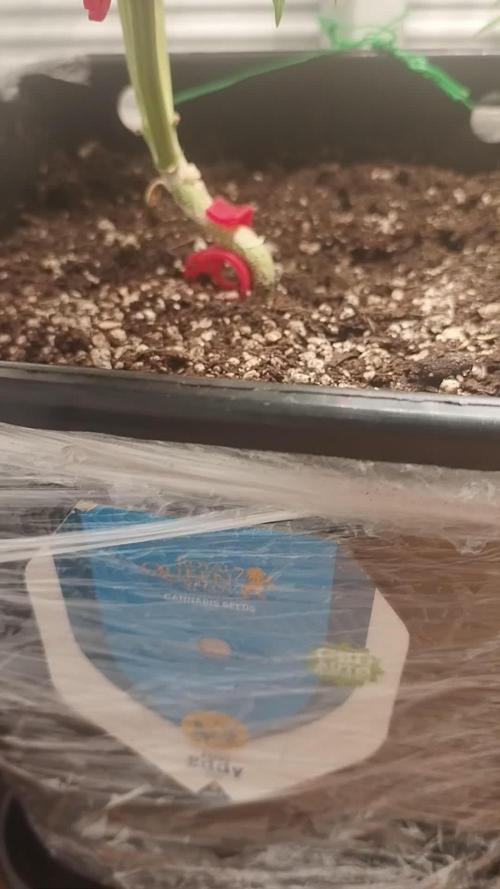The Grow Awards 2026 🏆 

































Likes
Comments
Share


@1Right_Angle
Follow
Mar 28th
- plants have been moved into 1 gal pots
- gently watered-in the plants to get them through the transplant
- DynoMyco was sprinkled into the 1 gallon pots ahead of the transfer, and the Solo Cups Root-Ball, was also sprinkled with Myco, making sure any exposed roots made good contact
Mar 29th
- a watering program begins tonight, Its posted above, next on 31st (day 3)
- p.m. feeding saw 400 ml h20 per plant. (First Official feeding and there is no containment for any water leaving the pots… i held-back 100ml ea. just to see if the Pots leaked… all good for now x 30)
Mar 31
- day 3 of the watering cycle; 350ml tonight (posted above)
- petals are big enough on the true leaves; foliar spray @ lites-out
- measured Soil pH, found it to be 7.1; Future waterings will be ~ 6.2-6.3 to help bring the soil pH a little lower towards mid 6’s
Apr 4
- watering tonight ~ 250ml ea
- topped-up the Soil in each Pot. Maximizing the Root Zone this whole grow
Likes
5
Share


@LevanteCultiva420
Follow
Aquí dejo imágenes de la segunda semana! He estado un poco liado y se me ha pasado! Mañana actualizaré también la 3ª semana que ya mañana arrancamos la 4ª y no van nada mal!!
La bolsa de CO2 THE EXHALE está cumpliendo y en si todos los parámetros del cultivo hasta el momento se están cumpliendo, ya os iré contando!!
Processing
Likes
34
Share


@LockDownGrow
Follow
My first time making alcohol tintcure
Using the c1 ,
Hold on tight gonna be a trip
Likes
3
Share


@Abendkraut
Follow
3rd week of flowering started and for only 2 weeks of flowering these ladies have grown very well. I had to pull my lamps even higher which the plants definitely enjoyed. they all gained about 10cm height in less than a week.
I added some CalMag to my water just prevent deficiency. I usually do it around week 9-10
Likes
18
Share


@RealTrees_uk
Follow
Everything going well since I’ve upgraded equipment 2 weeks into flower can’t wait to see the end result 👌🏻
Likes
17
Share


@Naujas
Follow
She is much prettier than she was a week ago :) I remembered that I have my first grow light, which is more compact and it will give me more space, so I changed my light, now the girl's side branches get light too:) I add a lot of video memes, because I really want to win Iphone16 pro ;) and those who don't take risks don't drink champagne:) good luck to everyone.
Likes
3
Share


@BRLGrow
Follow
Yellowing advancing brow spots, some leafs drying and falling off.
One girl I will flush tomorrow to cut on the weekend.
The other 2 have more one week or 2.
Is these yellowing hurt on the stage the girls are?
Processing
Likes
28
Share


@TrueNorth
Follow
-Strain: Purple Lemonade - Fast Buds
-Tent: 5x5 Gorilla Grow Tent
-Lights: Budget LED Grow Lights 2 x 250 Watt
LED Full Spec/Red Spec mixed boards
-Light Cycle: 18/6
-Soil: Fox Farm
-Air Circulation: AC Infinity Cloudline T6 Inline Duct Fan
WECLOME BACK GROWMIES! Week 12 here with our PURPLE LEMONADE by Fast Buds!
February, 09, 2020 (DAY 78) - YOO GROWMIES! Welcome to week 12 of our PURPLE LEMONADE! week 6 of flower to be exact! she is just thickening right out, i cant believe my eyes daily. she is just exploding even when i think it wont anymore. and to think there are still 2 weeks or so left..... she is still a thirsty and hungry one. she has about 5L with food every other day lol.
The smell is such a sweet citrus, i love when i touch it by accident and i get SLAPPED with that wonderful smell. The nugs have hues of purple nothing to crazy though!
February 12, 2020 (DAY 81) - WHAT UPPPPP!!!! here we are folks another update. think she is getting flushed starting this weekend. this will be the last feed then its onto that FLAWLESS FINISH by ADVANCED NUTRIENTS. hopefully im making the right choice......maybe another week wouldnt hurt....
Likes
145
Share


@Salokin
Follow
Hello Growmies,
Week 14 has blossomed before us, and the unfolding story of the grow is nothing short of inspiring.
The buds have ceased their stretch and have entered a stunning phase of swelling, with each day bringing more fullness. A palette of purple is now washing through the colas, hinting at the rich tapestry of flavors that awaits. It's a visual feast, and I can't help but feel this might be one of the most beautiful plants I've had the privilege to cultivate. Continuing with a steady rhythm, she receives 4 liters of nutrient solution every four days, sustaining her needs seamlessly. This grow has been a testament to the fire-and-forget approach, with the plant's robust health and vigorous growth doing all the talking. With both light spectrums blazing at 100%, she's now basking in the full 270 watts of power. Impressively, she's thriving under this intense light, demonstrating her strength and vitality.
I've also captured the PAR readings from various heights, showcasing her remarkable light absorption:
- The tallest colas stand under an impressive 1,271 and 1,326 μmol/m²/s.
- The mid-canopy level measures a healthy 822 μmol/m²/s.
- Down at the Scrog level, we're still seeing a substantial 522 μmol/m²/s.
These numbers reflect the careful tuning of our light setup, ensuring that every part of the plant is receiving the energy it needs.
This grow has been a journey of minimal stress and maximum reward. The ease with which this plant has flourished is a true joy, and sharing each update with you has added to the experience. As we move closer to harvest, the excitement is undeniable. If the appearance and growth rate are anything to go by, we are in for quite a treat.
Stay tuned for next week's update as we continue to nurture and admire the magnificent development of this plant.
Processing
Likes
25
Share


@Master_weeda
Follow
Bonjour à tous les padawans et les maîtres jedis
Pour cette semaine 4 au jour 23 ma plante fais 17 centimètres et son sixième noeud apparaît je décide donc de pratiquer un LST sur ma plante.
Pour ce j'utilise du fil de fer galvanisé que je plante directement dans le substrat en faisant attention de ne pas endommagé les racines car n'oublions pas que ce qui pousse dessus pousse aussi dessous.
Jour 17 je pulvérise du une solution composé d'une cuillère à café de savon noir mou dilué dans un litre d'eau en prévention d'éventuels nuisibles.
Je corrige mon LST suivant la pousse de ma plante ...
Pour ma par c'est la manière dont je procède mais petit rappel de la technique du LST:
Quand commencer à appliquer la technique LST
De nombreux cultivateurs commencent la manipulation dés que les plantes possèdent entre 3 et 6 nœuds ou une paire de feuilles. Durant cette première étape de la croissance, le tronc encore flexible est pliable sans risque qu’il ne se casse, même si au fur et à mesure du développement de la plante il sera de plus en plus difficile de le plier. Nous pouvons continuer à guider la croissance des branches durant toute la culture, même durant la floraison, ce qui pour cette étape représente un grand avantage face à la taille, qui n’est pas du tout recommandé une fois que la formation des têtes commence, cela stressera en effet la plante, ce qui aura pour effet de retarder la récolte.
Comment appliquer la technique de guidage LST
Si nous sommes prudents, la flexibilité naturelle des fibres du cannabis permet de plier leur tronc et branches avec une relative facilitée, même durant la floraison des plantes.
En utilisant une corde fine, nous pouvons accrocher la pointe de la plante à la base du pot par exemple ou à un tuteur que nous aurons planté dans le substrat. Nous plierons le tronc avec précaution et nous le fixerons avec la corde, à partir de là, nous pouvons augmenter progressivement la tension de la corde, chaque jour un peu plus, jusqu’à obtenir la position souhaitée. Soyez attentif à la réaction de la plante, essayez de ne pas appliquer trop de pression sur la corde et rappelez-vous que la flexibilité des branches peut varier d’une plante à l’autre.
Pour obtenir de meilleurs résultats, il suffit de suivre quelques règles simples. Pour commencer, nous devons choisir une corde fine mais pas trop pour ne pas blesser les troncs au fur et à mesure qu’ils grandissent et qu’ils deviennent plus gros.
Nous pouvons utiliser des crochets en plastique souple ou de n’importe quelle autre matière flexible pour éviter d’endommager les plantes. Spécialement en intérieur, utiliser des cordons en plastique de couleur (voir les diaries de @Silky) est très pratique pour voir facilement les accroches et faciliter le travail au milieu du réseau formés par les cordes, les tuteurs, les mailles ou les supports que nous aurons dans la culture. Bien entendu, en culture extérieure et surtout en guerilla nous ferons juste le contraire et nous utiliserons des matériaux de couleur qui n’attirent pas l’attention pour que notre jardin reste discret.
Pour stresser les plantes au minimum, la mieux est de réaliser ces manipulations le soir ou juste après que les lampes en intérieur s’éteignent, ce qui leur permettra de se remettre durant la nuit. Normalement, le jour suivant nous pourrons observer comme les pointes des branches que nous avons pliées se dressent de nouveau vers le haut à la recherche d’une source de lumière.
Je combine un pincage d'Apex au LST cela me permettra d'avoir une canopé plus homogène donc une meilleure pénétration lumineuse et par conséquent un meilleur rendement.
Que la force soit avec vous💪
Likes
Comments
Share


@Mxlan10
Follow
Harvest Day🏻 sweet smell, like some fresh cherries. Smells and looks great
Likes
5
Share


@123Grow
Follow
Just tucking away 🤣🤣🤣 Last weeks feeding was slightly too high for transition. I am realizing that the amount of fulvic/humid acid reduces the need for full strength ratios. This week we are going to feed 800 again, as the need for ppm’s has increased, but I am going to stay under 850 unless I see deficiency in leaves.
The photosynthesis plus has been added to the mix. I know, I have recharge. However, there are certain strains in PP that recharge does not have. Specifically there is a strain for absorbing more from the lights. I have some purple stems from the light being a little to intense. We will be adding a little more cal-mag to the next feeding also. Looks like feeding will take place Tuesday/Wednesday this week.
All plants are female and no Herms present for the party 😂😂
10-25 did a pre-feed of cal-mag, 8 oz. Later this evening I will do the main feeding 3 cups. The ratios are still 8-8-8 at 800 ppm’s. The extra ppm’s come in the form of extra cal-mag. Did some tucking as I am in stretch phase.
So I work with a grower who is 76 years old. He has some old school techniques that make sense. He pre-waters his containers with 25% water. The remainder 75% is either nutrients OR additives that need to be added to the water. I took it a step further. I added cal-mag to the pre-water stage. Then I fed the nutrients second stage. Cal-mag is the “carrier” for nutrients throughout the plant. “Adding the nutrients after, makes it easy for the nutrients to fully saturate the soil and reach all the roots. This also prevents salt build up.” Ron’s Words. I will say my containers held double the amount of water using his method.
10-28 added some reflective material around the sides. My Growmie at RedmanFarms suggested I add it to the room. I am inside of an open air room for flowering cycle. Today was watering day. First watering was a light dose of cal/mag. Second watering was kelp, seaweed, photosynthesis plus, monk beans SST, fulvic/humic acid.
One of the plants ( top left) seems to have a sulpher/magnesium deficiency ( it’s also the one with the soil I don’t like). I made some Iron/Tone tea by Espoma at 200 ppm’s and did a foliar feed. So far I see some progress on purple recessing and the growth has started to match the other 4. I have 1 more week of tucking to do and then I do a HEAVY defoliation on day 21. After than I won’t touch the plants other than feedings and water.
Likes
6
Share


@Suchy329
Follow
Weiß nicht was ich schreiben soll. Die Pflanze kommt Halt gut 😁 und gab keine Probleme
Likes
11
Share


@adam_pawloski87
Follow
Let’s Go!! What another great week it’s been, all babies have got there tops an looking super healthy!
Likes
5
Share


@Learntogrow818
Follow
Almost forgot to refill the humidifier, big mistake if left it without humidity for a long time.. It’s how my project plant started having problems..
Week 2 completed, now going into week three. Auto Gelatos were transplanted into 1 gl fabric pots.. I added some great white to the roots before transfer..
Likes
7
Share


@CampaCavallo
Follow
Buongiorno amici! Cosa ne dite, ci siamo? È arrivato il momento di raccogliere? 😍💚🍒🤪
... O meglio aspettare qualche foglia grande che diventa gialla?
Likes
13
Share


@CaptainKurryKush
Follow
Hello everyone, what's growing on?
So lads, this week I'll add some Big Bud Coco in their nutrition.
Day 43 - The plants were defoliated and removed some of the bottom buds that weren't developing well, so to avoid waste of energy and nutrients. I hope this help the main colas in their grow.
Day 46 - They are doing great and I already can sense from the flowers. The plant 1 is spreading well and with an even canopy, while the plant 2 is getting very dense and bushy. Both of them are being trained daily. Because of the hot days we had, they got 500mL a day before light time.
























